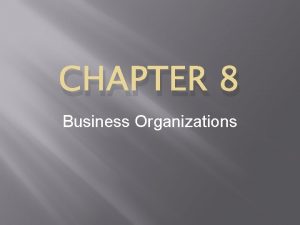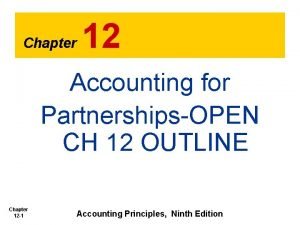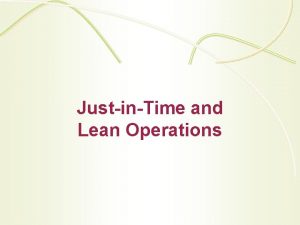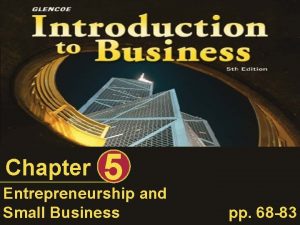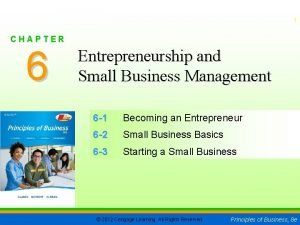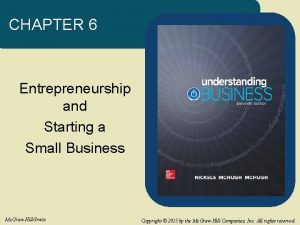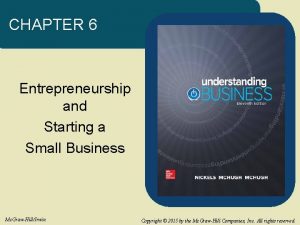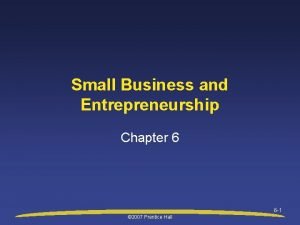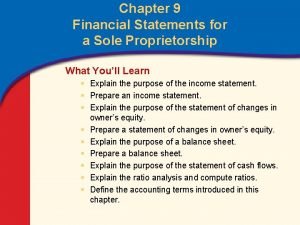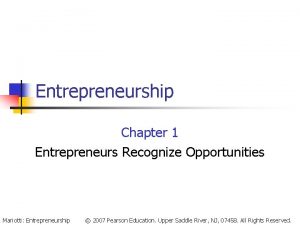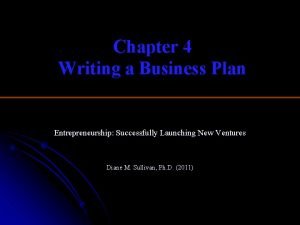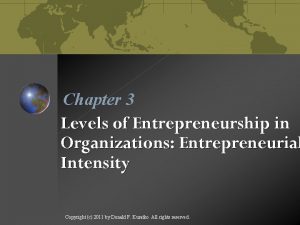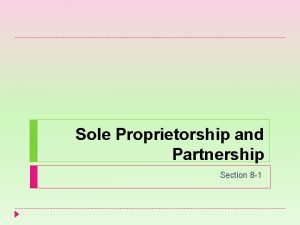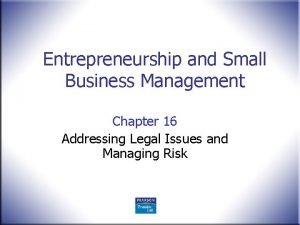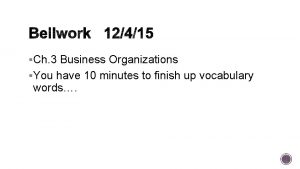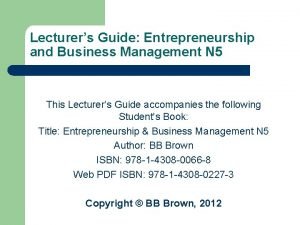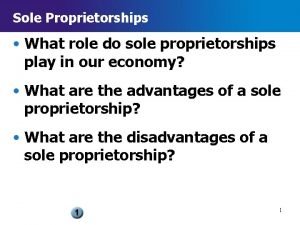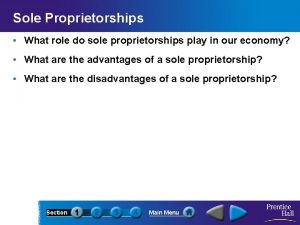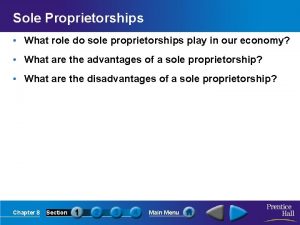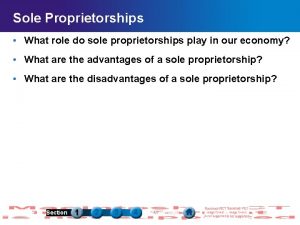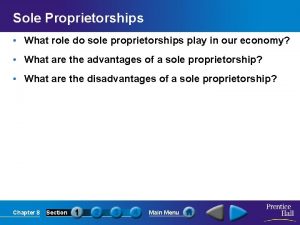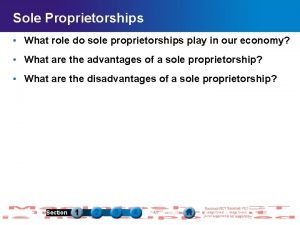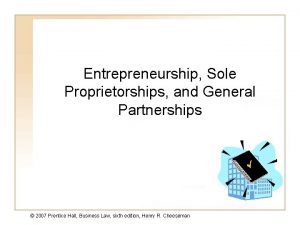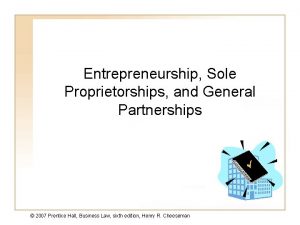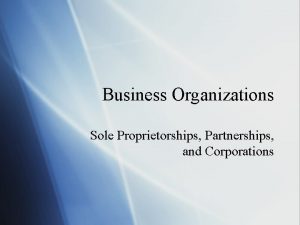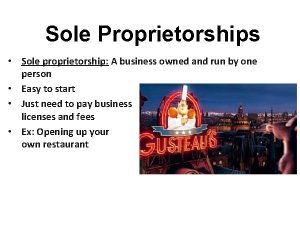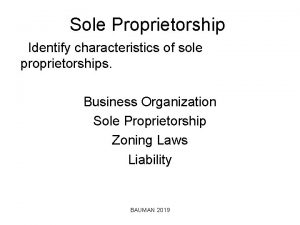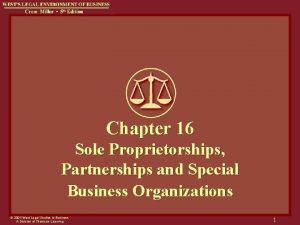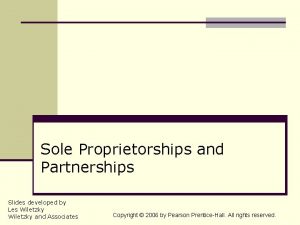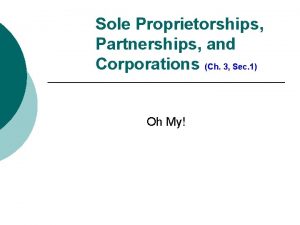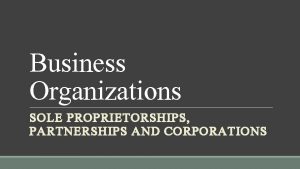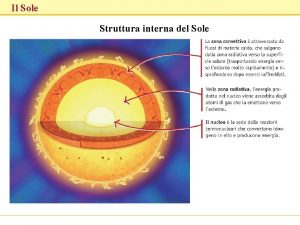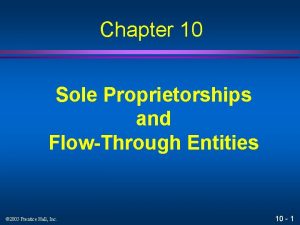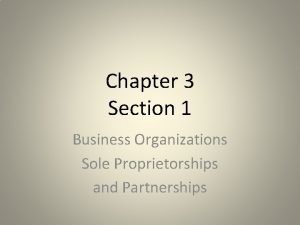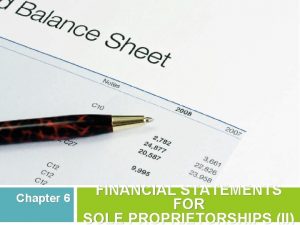Chapter 34 Entrepreneurship Sole Proprietorships and General Partnerships










































- Slides: 42

Chapter 34 Entrepreneurship, Sole Proprietorships, and General Partnerships © 2007 Prentice Hall, Business Law, sixth edition, Henry R. Cheeseman 19 - 1 31

Entrepreneur A person who forms and operates a new business either by him- or herself or with others. © 2007 Prentice Hall, Business Law, sixth edition, Henry R. Cheeseman 19 - 2 31

Entrepreneurial Forms of Conducting Business Sole Proprietorship General Partnership Limited Liability Company © 2007 Prentice Hall, Business Law, sixth edition, Henry R. Cheeseman 19 - 3 31

Sole Proprietorship • Owner is actually the business. • Business is not a separate legal entity. • Most common form of business organization in the United States. © 2007 Prentice Hall, Business Law, sixth edition, Henry R. Cheeseman 19 - 4 31

Advantages of a Sole Proprietorship • Ease and low cost of formation. • Owner can make all management decisions. – hiring and firing employees. – No other approvals required. • Sole proprietor owns all of the business • Has the right to receive all of the business’s profits. • Easily transferred or sold © 2007 Prentice Hall, Business Law, sixth edition, Henry R. Cheeseman 19 - 5 31

Disadvantages of a Sole Proprietorship • Access to capital is limited to: – personal funds plus – any loans he or she can obtain. • Legally responsible for the business’s contracts • Responsible for any torts committed in the course of employment. © 2007 Prentice Hall, Business Law, sixth edition, Henry R. Cheeseman 19 - 6 31

Creation of a Sole Proprietorship • No formalities. • No federal or state government approval is required. • Some local governments require a license to do business within the city. © 2007 Prentice Hall, Business Law, sixth edition, Henry R. Cheeseman 19 - 7 31

Personal Liability of a Sole Proprietor • The sole proprietor bears the risk of loss of the business. – Will lose his or her entire capital contribution if the business fails. • The sole proprietor has unlimited personal liability. • Creditors may recover claims against the business from the sole proprietor’s personal assets. © 2007 Prentice Hall, Business Law, sixth edition, Henry R. Cheeseman 19 - 8 31

Personal Liability of a Sole Proprietor (continued) Sole Proprietorsh ip Debt or obligation owed Third Party Capital investment Sole Proprieto r (Owner) Personal liability for sole proprietorship’s debts and obligations © 2007 Prentice Hall, Business Law, sixth edition, Henry R. Cheeseman 19 - 9 31

General Partnership • Voluntary association • Two or more people • Carry on business for profit • Creates rights and duties between partners and with third parties • General partners personally liable for the debts and obligations of the partnership. © 2007 Prentice Hall, Business Law, sixth edition, Henry R. Cheeseman 19 - 10 31

General Partnership General Partnersh ip Capital investment General Partner Debt or obligation owed Personal liability for partnership’s debts and obligations Third Party General Partner © 2007 Prentice Hall, Business Law, sixth edition, Henry R. Cheeseman 19 - 11 31

Uniform Partnership Act (UPA) • • Model act Codifies partnership law Most states have adopted Covers most problems that arise in the formation, operation, and dissolution of ordinary partnerships © 2007 Prentice Hall, Business Law, sixth edition, Henry R. Cheeseman 19 - 12 31

Entity Theory of Partnership • UPA considers partnerships as separate legal entities. • Partnerships can: – Hold title to personal and real property – Transact business in the partnership name – Sue in the partnership name © 2007 Prentice Hall, Business Law, sixth edition, Henry R. Cheeseman 19 - 13 31

General Partnership Name • Can operate under name of any one or all of partners • May use fictitious name – Must file fictitious business name certificate – Publish notice – Cannot be similar to name used by another business © 2007 Prentice Hall, Business Law, sixth edition, Henry R. Cheeseman 19 - 14 31

Requirements for a General Partnership • UPA states that a partnership is: 1. A voluntary association of two or more persons n Includes natural persons, partnerships, corporations 2. Carrying on a business 3. As co-owners n All partners must agree to participation 4. For profit © 2007 Prentice Hall, Business Law, sixth edition, Henry R. Cheeseman 19 - 15 31

Evidence of Partnership • Prima facie evidence: – Receipt of a share of business profits • Compelling evidence: – Agreement to share in profits and losses – Right to participate in management © 2007 Prentice Hall, Business Law, sixth edition, Henry R. Cheeseman 19 - 16 31

Partnership Agreement • May be written or oral – Statute of Frauds applies • No formalities required • Recommended that it be in writing – Called partnership agreement or articles of partnership – UPA will fill gaps © 2007 Prentice Hall, Business Law, sixth edition, Henry R. Cheeseman 19 - 17 31

Rights Among Partners • Unless otherwise agreed, each partner: – Has a right to participate in management, and – Has an equal vote on partnership matters. • Under UPA, a simple majority decides most ordinary partnership matters. © 2007 Prentice Hall, Business Law, sixth edition, Henry R. Cheeseman 19 - 18 31

Partners’ Rights to Share in Profits • UPA mandates right to an equal share in profits and losses • Agreements often provide otherwise – If agreement describes sharing of profits, but losses are silent, then losses are shared in same proportion – If agreement states sharing of losses, but is silent as to profits, then profits are shared equally © 2007 Prentice Hall, Business Law, sixth edition, Henry R. Cheeseman 19 - 19 31

Right to Compensation and Reimbursement • UPA provides that no partner is entitled to remuneration – Implied partners will devote full time and service to partnership • Partner entitled to indemnification – Partner to be reimbursed for expenditures incurred on behalf of the partnership © 2007 Prentice Hall, Business Law, sixth edition, Henry R. Cheeseman 19 - 20 31

Right to Return of Loans and Capital • Partner entitled to repayment of loan – Right is subordinated to claims of creditors who are not partners • Partners entitle to have capital contributions returned at termination of partnership – Right is subordinated to rights of creditors © 2007 Prentice Hall, Business Law, sixth edition, Henry R. Cheeseman 19 - 21 31

Right to Information • Partner has right to true and full information – From any partner – All things affecting partnership • Partner has a duty to provide information • Partnership books must be kept at partnership’s principal place of business – Partners have absolute right to inspect and copy records © 2007 Prentice Hall, Business Law, sixth edition, Henry R. Cheeseman 19 - 22 31

Duties Among Partners Duty of Loyalty Duty of Obedience Duty to Inform Duty of Care © 2007 Prentice Hall, Business Law, sixth edition, Henry R. Cheeseman 19 - 23 31

Duty of Loyalty • Duty that a partner owes not to act adversely to the interests of the partnership. • Duty is imposed by law • Cannot be waived. • In case of conflict between partnership interests and personal interests, partner must choose the interest of the partnership. © 2007 Prentice Hall, Business Law, sixth edition, Henry R. Cheeseman 19 - 24 31

Partners breach their duty of loyalty if they: 1. Self-deal with the partner-ship without permission 2. Usurp a partnership opportunity 3. Compete with the partner-ship without permission 4. Make secret profits from partnership business 5. Disclose confidential partnership information 6. Misuse partnership property 7. Make other breaches of their fiduciary duty © 2007 Prentice Hall, Business Law, sixth edition, Henry R. Cheeseman 19 - 25 31

Duty of Care • Partners must use the same level of care and skill that a reasonable person in the same position would use in the same circumstances. • A breach of the duty of care is negligence. • A partner is liable to the partnership for any damages caused by his or her negligence. © 2007 Prentice Hall, Business Law, sixth edition, Henry R. Cheeseman 19 - 26 31

Duty to Inform • Duty partner owes to inform his or her co-partners of all information he or she possesses, that is relevant to the affairs of the partnership. • Knowledge is imputed to other partners. © 2007 Prentice Hall, Business Law, sixth edition, Henry R. Cheeseman 19 - 27 31

Duty of Obedience • Duty that partners must adhere to the provisions of the partnership agreement and the decisions of the partnership. • Partner who breaches this duty is liable to the partnership for any damages caused by the breach. © 2007 Prentice Hall, Business Law, sixth edition, Henry R. Cheeseman 19 - 28 31

Right to an Accounting • Partners cannot sue partnership • They may bring an action for an accounting – Formal judicial proceeding in which the court is authorized to: • Review the partnership and the partners’ transactions, and • Award each partner his or her share of the partnership assets © 2007 Prentice Hall, Business Law, sixth edition, Henry R. Cheeseman 19 - 29 31

Tort Liability • Partnership is liable for the tortious act of a partner, employee, or agent that is committed while the person is acting within the ordinary course of partnership business or with the authority of his or her co-partners. – Both negligence and intentional torts covered © 2007 Prentice Hall, Business Law, sixth edition, Henry R. Cheeseman 19 - 30 31

Joint and Several Liability • Partners are jointly and severally liable for tort liability of the partnership. – i. e. , the plaintiff can sue one or more of the partners separately. – If successful, the plaintiff can recover the entire amount of the judgment from any or all of the defendant-partners. – Release of one partner does not discharge the others. © 2007 Prentice Hall, Business Law, sixth edition, Henry R. Cheeseman 19 - 31 31

Contract Liability • Partners are jointly liable for contracts and debts of partnership. • Third party must name all partners in suit. – If suit does not list all, judgment cannot be collected. – If one is released, all are released. • Successful third party may collect judgment against any or all partners. – Partners may seek indemnification if they pay more than their share. © 2007 Prentice Hall, Business Law, sixth edition, Henry R. Cheeseman 19 - 32 31

Summary: Personal Liability of General Partners Issue Joint Liability Joint and Several Liability Type of lawsuit Contract action Tort action Defendants Plaintiff must name all partners as defendants Plaintiff can sue partners individually Recover y If successful, the plaintiff can recover the judgment against all or any of the defendants If successful, the plaintiff can recover the judgment against all or any of the named defendants Indemni- Partner who pays judgment can fication recover contribution from other partners for their share of the judgment Partner who pays judgment can recover contribution from other partners for their share of the judgment © 2007 Prentice Hall, Business Law, sixth edition, Henry R. Cheeseman 19 - 33 31

Liability of Incoming Partners • New partner who is admitted to the partnership is liable for the existing debts and obligations (antecedent debts) of the partnership only to the extent of his or her capital contribution. • The new partner is personally liable for debts and obligations incurred by the partnership after becoming a partner. © 2007 Prentice Hall, Business Law, sixth edition, Henry R. Cheeseman 19 - 34 31

Dissolution of General Partnership • Defined as: – “Change in the relation of the partners caused by any partner ceasing to be associated in the carrying on of the business”. • Partnership for a term – For a fixed duration – Until event occurs – Terminates automatically at end of time or when objective accomplished. • Partnership at will – Partner may rightfully withdraw and dissolve partnership at any time. © 2007 Prentice Hall, Business Law, sixth edition, Henry R. Cheeseman 19 - 35 31

Winding-Up • Process of liquidating the partnership’s assets and distributing the proceeds to satisfy claims against the partnership. • The surviving or remaining partners have the right to wind-up the partnership. • A bankrupt partner cannot participate in the winding-up of a partnership. © 2007 Prentice Hall, Business Law, sixth edition, Henry R. Cheeseman 19 - 36 31

Notice of Dissolution • Terminates partners’ actual authority to enter into contracts or act on behalf of partnership • Notice must be given to certain third parties – Third parties who dealt with partnership must be given actual notice. – Third parties who had knowledge of partnership must be given actual or constructive notice. – Third parties who had no knowledge owed no notice. • If no notice given, apparent authority to continue to bind partnership © 2007 Prentice Hall, Business Law, sixth edition, Henry R. Cheeseman 19 - 37 31

Distribution of Assets 1. 2. 3. 4. Upon the winding-up of a dissolved partnership, the assets of the partnership are distributed in the following order : Creditors (except partners who are creditors) Creditor-partners Capital contributions Profits © 2007 Prentice Hall, Business Law, sixth edition, Henry R. Cheeseman 19 - 38 31

Wrongful Dissolution • Partner has power to withdraw at any time, but may not have the right to withdraw. – Withdraws before expiration of term – Withdraws before occurrence of event • Partner is liable for damages caused by the wrongful dissolution of the partnership. © 2007 Prentice Hall, Business Law, sixth edition, Henry R. Cheeseman 19 - 39 31

Continuation of Partnership after Dissolution • Remaining partners have right to continue after dissolution • Continuation agreement – Sets forth events that allow for continuation, amount paid to out-going partners, and other details. • Old partnership dissolved and new partnership created – Creditors of old partnership become creditors of new partnership – Have equal status with creditors of new partnership © 2007 Prentice Hall, Business Law, sixth edition, Henry R. Cheeseman 19 - 40 31

Liability of Outgoing Partners • Dissolution of partnership does not discharge liability of outgoing partners for existing partnership debts and obligations © 2007 Prentice Hall, Business Law, sixth edition, Henry R. Cheeseman 19 - 41 31

Right of Survivorship • Upon the death of a partner, deceased partner’s right in specific partnership property vests in the remaining partner or partners • Does not pass to heirs or next of kin – Value passes to beneficiaries and heirs • Upon death of last partner, rights in specific partnership property vest in the deceased partner’s legal representative © 2007 Prentice Hall, Business Law, sixth edition, Henry R. Cheeseman 19 - 42 31
 Chapter 8 section 1 sole proprietorships
Chapter 8 section 1 sole proprietorships Introduction to entrepreneurship module pdf
Introduction to entrepreneurship module pdf Accounting for partnerships chapter 12 solutions
Accounting for partnerships chapter 12 solutions Chapter 12 accounting for partnerships answers
Chapter 12 accounting for partnerships answers Adp accenture
Adp accenture Word partnerships examples
Word partnerships examples Product development partnerships
Product development partnerships Characteristics of just-in-time partnerships do not include
Characteristics of just-in-time partnerships do not include Maintaining effective partnerships
Maintaining effective partnerships Account www.publicpartnerships.com
Account www.publicpartnerships.com Epsrc prosperity partnerships
Epsrc prosperity partnerships Chapter 6 entrepreneurship and small business management
Chapter 6 entrepreneurship and small business management Chapter 5 entrepreneurship and small business
Chapter 5 entrepreneurship and small business Chapter 5 entrepreneurship
Chapter 5 entrepreneurship Chapter 6 entrepreneurship and small business management
Chapter 6 entrepreneurship and small business management Ben cathers
Ben cathers Five roots of opportunity
Five roots of opportunity Chapter 5 entrepreneurship and small business
Chapter 5 entrepreneurship and small business Chapter 6 entrepreneurship and starting a small business
Chapter 6 entrepreneurship and starting a small business Chapter 6 entrepreneurship and starting a small business
Chapter 6 entrepreneurship and starting a small business Roles in a small business
Roles in a small business Chapter 6 entrepreneurship and small business management
Chapter 6 entrepreneurship and small business management Sole proprietorship income statement
Sole proprietorship income statement In restructuring corporate thinking, top management should
In restructuring corporate thinking, top management should Chapter 1 entrepreneurship
Chapter 1 entrepreneurship Entrepreneurship chapter 4
Entrepreneurship chapter 4 Entrepreneurship chapter 6
Entrepreneurship chapter 6 The entrepreneurial grid
The entrepreneurial grid Chapter 2 entrepreneurship
Chapter 2 entrepreneurship Diferencia entre gran plano general y plano general
Diferencia entre gran plano general y plano general Where did general lee surrender to general grant?
Where did general lee surrender to general grant? Disadvantages of sole trader
Disadvantages of sole trader Advantage and disadvantage of general partnership
Advantage and disadvantage of general partnership Sole proprietorship pros and cons
Sole proprietorship pros and cons Forms of business organization venn diagram
Forms of business organization venn diagram What is a sole trader bbc bitesize
What is a sole trader bbc bitesize Venn diagram of sole proprietorship and partnership
Venn diagram of sole proprietorship and partnership Sole proprietorship partnership corporation venn diagram
Sole proprietorship partnership corporation venn diagram Entrepreneurship and small business management
Entrepreneurship and small business management Features of entrepreneurship
Features of entrepreneurship Motivation and entrepreneurship development
Motivation and entrepreneurship development Macro enterprises meaning
Macro enterprises meaning Entrepreneurship and business management n5 textbook pdf
Entrepreneurship and business management n5 textbook pdf
